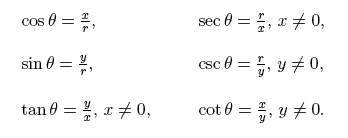How do the graphs of Sine and Cosine relate to each of the others?
If we think about how all the Trig functions relate to sine and cosine we will see a connection. The rest of the functions have some sort of relation that has sine or cosine in it.
a).png)
Tangent with cosine and sine
We know that tangent is equal to the trig function of sin over cosine. We have to see what will make this function undefined. The only way for it to be undefined is by having cosine equal 0. If the function is undefined we see that an asymptote is being created, not letting the graph touch or go through that asymptote it serves as a wall. We see on the graph that whenever the cosine graph is on the x axis with the value of zero there is a break on the tangent graph demonstrating the placement of the asymptote.
b).png)
cotangent with sine and cosine
The trig function for cotangent is cosine over sine. If we want to check for asymptotes we have to see where on the graph this would be true in which sine will equal 0. Sine is equal to 0 in 0, pi and 2pi. Whenever sine equals 0 on the graph we see that there is a break that cotangent cannot touch representing the asymptote. We can also see the relation between tan and cot they are faced the opposite way one is uphill the other downhill and that is because of the other and place that the asymptotes are at because
C).png)
Secant with Cosine
The trig function of secant is r/cosine. "r" stands for 1 since we are using the values of the unit circle. So this means that the trig function is 1/cosine. In order to have asymptotes there must be a place on the graph that will make this function undefined. The only way for it to be undefined is by having cosine equal 0. On the unit circle unit circle cosine =0 on pi/2 and 3pi/2. This means that there will be an asymptote there. If we look at the graph we see that where ever cosine is on the x axis with a value of 0 then the graph for secant splits. This split represent the asymptote that cannot be touched.
d).png)
Cosecant and sine
The trig function for cosecant is r/sine. When we are talking about the unit circle the radius is one making the function just 1/sine. To find the asymptotes we have to see in which part of the graph will it be undefined making sine=0. In the Unit circle sine is 0 at 0, pi, and 2pi. 0 is the start of the period that we are looking at and 2pi is the end which means that there is one asymptote in between being pi. If we see the graph of sine we see that the graph lands on the value of 0 on the x axis on the same points creating the asymptotes that separate the graph for cosecant making this impossible for the graph of cosecant to touch because of it. We draw the u shapes on the hump of the sine graph put it facing up if it is above the x axis and face down if it is below.
The direction in which the hump is going( above or below the x-axis) depends on ASTC. On what the value will end up being on each quadrant.
In Cooperation with desmos.com created by Mrs. Kirch
.png) Tangent Graph
Tangent Graph .png) Cotangent Graph
Cotangent Graph.png)
.png)
.png)
.png)


